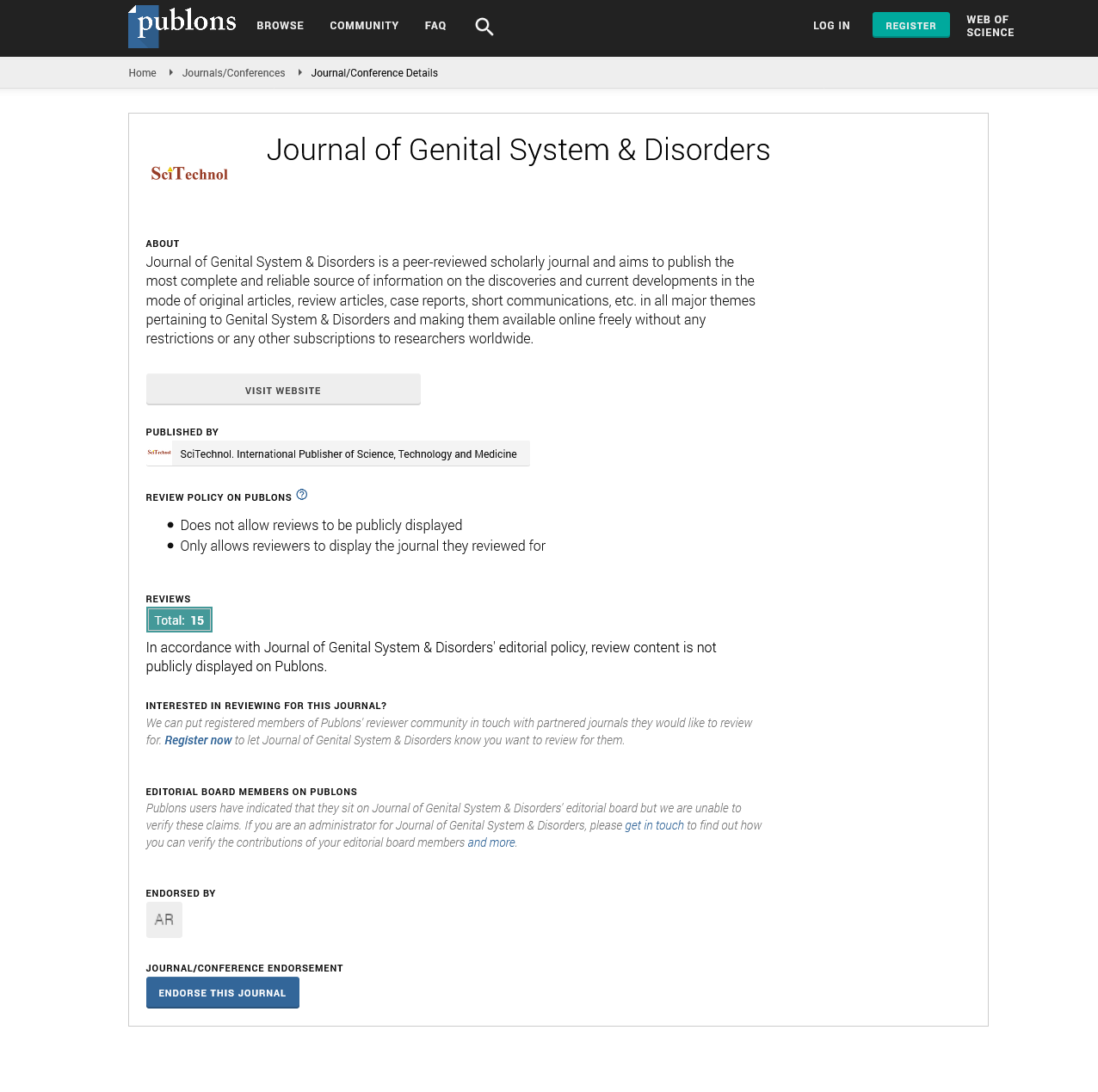Perspective, J Genit Syst Disord Vol: 12 Issue: 1
Urogynaecology: An Overview of Common Conditions and Treatment Options
Markus Albrecht*
Department of Medicine, Otto-von-Guericke University, Magdeburg, Germany
*Corresponding Author: Markus Albrecht
Markus Albrecht, Department of Medicine, Otto-von-
Guericke University, Magdeburg, Germany,
E-mail: albrechtmarkus@gmail.com
Received date: 22 February, 2023, Manuscript No. JGSD-23-93319;
Editor assigned date: 24 February, 2023, Pre QC No. JGSD-23-93319 (PQ);
Reviewed date: 10 March, 2023, QC No. JGSD-23-93319;
Revised date: 17 March, 2023, Manuscript No. JGSD-23-93319 (R);
Published date: 24 March, 2023, DOI: 10.4172/ 2325-9728.1000266
Citation: Albrecht M (2023) Urogynaecology: Synoptic Overview of Common Conditions and Treatment Options. J Genit Syst Disord 12:1.
Description
Urogynaecology is a branch of gynaecology that focuses on the diagnosis and treatment of conditions related to the pelvic floor and urinary tract. The pelvic floor is a complex system of muscles, ligaments, and tissues that support the bladder, uterus, and rectum. When these structures become weakened or damaged, they can lead to a range of conditions, including urinary incontinence, pelvic organ prolapse, and bladder pain syndrome.
Since other imaging modalities are unable to identify the underlying cause of ureteral blockage, CT IVP in urogynecology is generally used to evaluate hematuria or to identify the aetiology of ureteral obstruction. The CT IVP is useful for determining the anatomy and function of the kidneys, checking for abnormalities, and identifying masses in the pelvis and abdomen. Its capacity to provide cross-sectional view of the whole urinary system is what gives it this diagnostic skill. The quick and continuous capture of scans via sizable body areas is made possible by helical CT technology. The images are often shown in an axial two-dimensional manner with the possibility to recreate three dimensions. With this extra capabilities, the urinary tract and its surrounding tissues have even better anatomic detail, and helical CT can properly describe intrinsic and extrinsic causes of ureteral obstruction.
Urinary incontinence
Urinary incontinence is a common urogynaecological condition that affects women of all ages. It occurs when the pelvic floor muscles are weak or damaged, leading to involuntary leakage of urine. Stress Urinary Incontinence (SUI) is the most common type and occurs when the bladder is put under stress, such as during exercise or when coughing or sneezing. Urge Urinary Incontinence (UUI) occurs when there is a sudden urge to urinate that cannot be delayed, leading to leakage. Treatment options for urinary incontinence include pelvic floor exercises, medications, and surgery.
Pelvic organ prolapse
Pelvic organ prolapse (POP) is a condition in which the pelvic organs, such as the bladder, uterus, or rectum, descend from their normal position and push against the vaginal walls. This can lead to discomfort, pain, and incontinence. POP is more common in women who have had multiple vaginal deliveries, menopause, and obesity. Treatment options for POP include pelvic floor exercises, pessaries, and surgery.
Bladder pain syndrome
Bladder pain syndrome, also known as interstitial cystitis, is a chronic condition that causes pain and discomfort in the bladder and pelvis. The exact cause of bladder pain syndrome is unknown, but it is thought to be related to damage to the bladder lining. Symptoms of bladder pain syndrome include pain during urination, frequent urination, and pelvic pain. Treatment options for bladder pain syndrome include medications, bladder distension, and nerve stimulation.
Overactive bladder
Overactive Bladder (OAB) is a condition in which the bladder contracts too often, leading to a sudden urge to urinate that cannot be delayed. OAB is more common in women than men and can be caused by a range of factors, including nerve damage, infections, and medications. Treatment options for OAB include medications, bladder training, and nerve stimulation.
Urogynaecological conditions are common and can significantly impact a woman's quality of life. Treatment options vary depending on the severity of the condition and can range from pelvic floor exercises to surgery. Early diagnosis and treatment can help manage symptoms and improve overall well-being. It is important for women to seek medical advice if they experience any symptoms related to urogynaecological conditions.
 Spanish
Spanish  Chinese
Chinese  Russian
Russian  German
German  French
French  Japanese
Japanese  Portuguese
Portuguese  Hindi
Hindi 
